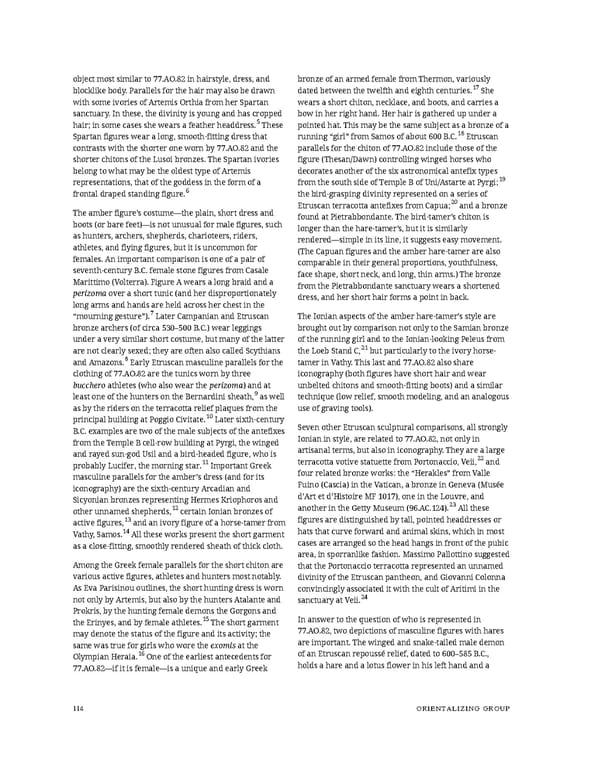object most similar to 77.AO.82 in hairstyle, dress, and bronze of an armed female from Thermon, variously blocklike body. Parallels for the hair may also be drawn dated between the twelfth and eighth centuries.17 She with some ivories of Artemis Orthia from her Spartan wears a short chiton, necklace, and boots, and carries a sanctuary. In these, the divinity is young and has cropped bow in her right hand. Her hair is gathered up under a hair; in some cases she wears a feather headdress.5 These pointed hat. This may be the same subject as a bronze of a Spartan figures wear a long, smooth-fitting dress that running “girl” from Samos of about 600 B.C.18 Etruscan contrasts with the shorter one worn by 77.AO.82 and the parallels for the chiton of 77.AO.82 include those of the shorter chitons of the Lusoi bronzes. The Spartan ivories figure (Thesan/Dawn) controlling winged horses who belong to what may be the oldest type of Artemis decorates another of the six astronomical antefix types representations, that of the goddess in the form of a from the south side of Temple B of Uni/Astarte at Pyrgi;19 frontal draped standing figure.6 the bird-grasping divinity represented on a series of Etruscan terracotta antefixes from Capua;20 and a bronze The amber figure’s costume—the plain, short dress and found at Pietrabbondante. The bird-tamer’s chiton is boots (or bare feet)—is not unusual for male figures, such longer than the hare-tamer’s, but it is similarly as hunters, archers, shepherds, charioteers, riders, rendered—simple in its line, it suggests easy movement. athletes, and flying figures, but it is uncommon for (The Capuan figures and the amber hare-tamer are also females. An important comparison is one of a pair of comparable in their general proportions, youthfulness, seventh-century B.C. female stone figures from Casale face shape, short neck, and long, thin arms.) The bronze Marittimo (Volterra). Figure A wears a long braid and a from the Pietrabbondante sanctuary wears a shortened perizomaover a short tunic (and her disproportionately dress, and her short hair forms a point in back. long arms and hands are held across her chest in the “mourning gesture”).7 Later Campanian and Etruscan The Ionian aspects of the amber hare-tamer’s style are bronze archers (of circa 530–500 B.C.) wear leggings brought out by comparison not only to the Samian bronze under a very similar short costume, but many of the latter of the running girl and to the Ionian-looking Peleus from are not clearly sexed; they are often also called Scythians the Loeb Stand C,21 but particularly to the ivory horse- and Amazons.8Early Etruscan masculine parallels for the tamer in Vathy. This last and 77.AO.82 also share clothing of 77.AO.82 are the tunics worn by three iconography (both figures have short hair and wear buccheroathletes (who also wear the perizoma) and at unbelted chitons and smooth-fitting boots) and a similar least one of the hunters on the Bernardini sheath,9 as well technique (low relief, smooth modeling, and an analogous as by the riders on the terracotta relief plaques from the use of graving tools). principal building at Poggio Civitate.10 Later sixth-century B.C. examples are two of the male subjects of the antefixes Seven other Etruscan sculptural comparisons, all strongly from the Temple B cell-row building at Pyrgi, the winged Ionian in style, are related to 77.AO.82, not only in and rayed sun-god Usil and a bird-headed figure, who is artisanal terms, but also in iconography. They are a large 11 terracotta votive statuette from Portonaccio, Veii,22 and probably Lucifer, the morning star. Important Greek masculine parallels for the amber’s dress (and for its four related bronze works: the “Herakles” from Valle iconography) are the sixth-century Arcadian and Fuino (Cascia) in the Vatican, a bronze in Geneva (Musée Sicyonian bronzes representing Hermes Kriophoros and d’Art et d’Histoire MF 1017), one in the Louvre, and other unnamed shepherds,12certain Ionian bronzes of another in the Getty Museum (96.AC.124).23 All these active figures,13 and an ivory figure of a horse-tamer from figures are distinguished by tall, pointed headdresses or Vathy, Samos.14 All these works present the short garment hats that curve forward and animal skins, which in most as a close-fitting, smoothly rendered sheath of thick cloth. cases are arranged so the head hangs in front of the pubic area, in sporranlike fashion. Massimo Pallottino suggested Among the Greek female parallels for the short chiton are that the Portonaccio terracotta represented an unnamed various active figures, athletes and hunters most notably. divinity of the Etruscan pantheon, and Giovanni Colonna As Eva Parisinou outlines, the short hunting dress is worn convincingly associated it with the cult of Aritimi in the not only by Artemis, but also by the hunters Atalante and sanctuary at Veii.24 Prokris, by the hunting female demons the Gorgons and the Erinyes, and by female athletes.15 The short garment In answer to the question of who is represented in may denote the status of the figure and its activity; the 77.AO.82, two depictions of masculine figures with hares same was true for girls who wore the exomis at the are important. The winged and snake-tailed male demon Olympian Heraia.16 One of the earliest antecedents for of an Etruscan repoussé relief, dated to 600–585 B.C., 77.AO.82—if it is female—is a unique and early Greek holds a hare and a lotus flower in his left hand and a 114 ORIENTALIZING GROUP
 Ancient Carved Ambers in the J. Paul Getty Museum Page 123 Page 125
Ancient Carved Ambers in the J. Paul Getty Museum Page 123 Page 125